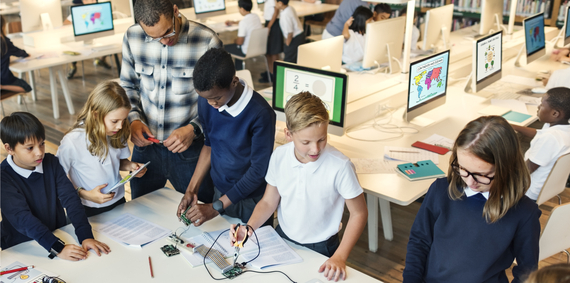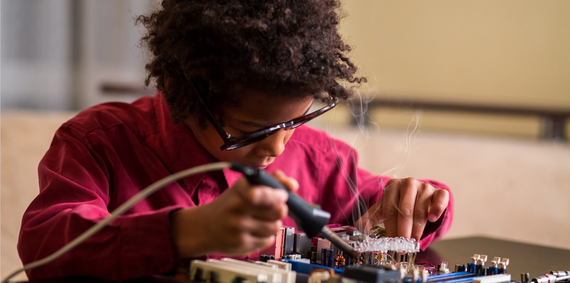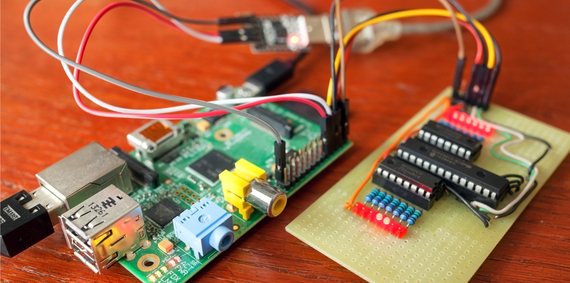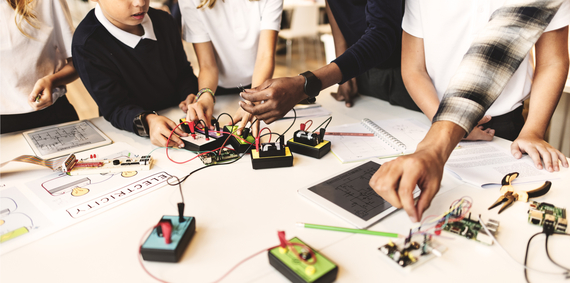
"There were more than 135 million adult makers, more than half of the total adult population in America, in 2015."
What is a makerspace? You've no doubt been hearing that word more than a few times over the past several years. Makerspaces, also called hackerspaces, hackspaces, and fablabs, are collaborative spaces where people gather to get creative with DIY projects, invent new ones, and share ideas. Since the first official makerspace convened six years ago in a library in upstate New York, libraries have remained an ideal setting for makerspace events across the country. Many offer community resources like 3D printers, software, electronics, craft and hardware supplies, and more. The idea of a communal creative space has only gained momentum and become increasingly popular over the years, and the makers' movement shows no signs of slowing down.
There were more than 135 million adult makers, more than half of the total adult population in America, in 2015. The White House even held its own inaugural Maker Faire in 2014, inspiring President Obama to declare an official National Week of Making the following year. Read on to learn more about library makerspaces and how one might benefit your community.

Articles & Blog Posts on Makerspaces
1.) Library as Makerspace
The Library as Makerspace blog, run by the Duxbury Free Library in Massachusetts, shares the experiences of its librarians in the process of transitioning from a content collection-only facility to a content creation-inspired makerspace. Bloggers share ideas for makerspace programs for children, teens, and adults, with a goal of "reimagining our role in a rapidly changing world."
2.) Renovated Learning
Curated by Diana Rendina, media specialist, teacher, and librarian at Stewart Middle Magnet School in Tampa, Florida, this blog documents Diana's journey of starting a STEM-based makerspace at her own school's library from the ground up. Posts include lessons and reflections on her own experience as well as resources for other makerspace hosts, including a "start here" section for beginners.
3.) The Makerspace in the Library: What it Means for Your Classroom
This recent post on a blog titled "The Unquiet Mind" explores the author's first experience attending the National Writing Project Annual Meeting in 2017; this year, the NWP panel discussed growing interest in makerspaces at libraries and their implications for teachers, library staff, and the learning process as a whole.
4.) A Librarian's Guide to OER in the Maker Space
This article, written by library media specialist and author Laura Fleming, introduces librarians and educators to the open educational resources (OER) movement, and focuses on how to integrate STEM-oriented makerspaces and other disciplines into the traditional learning space.
5.) Growing Learning Communities Through School Libraries and Makerspaces-Creating, Constructing, Collaborating, Contributing
Another informative post on "The Unquiet Mind," this article served as one of the site's first comprehensive guides to makerspaces, exploring a variety of possibilities for creating a collaborative learning environment at locations across the U.S. The post accompanies a presentation about makerspaces given by the author to the Independent School Library Exchange of Southern California.
6.) Library Friday: Visiting Fayetteville Free Library
Here on INFOSPACE, the official blog of the Syracuse University iSchool, blogger and master's candidate in library and information science Kayla Del Biondo, explores one of the country's leading university makerspaces at the Fayetteville Free Library as part of her Library Friday Series.
7.) Make it Work! Starting a Makerspace in an Academic Library, Phase 1
Among many authoritative posts on ACRLog.com, a blog site exclusively by and for academic and research librarians, this post outlines a multi-phase process for creating a makerspace at the grassroots level, addressing crucial concerns for working librarians. Hannah Pope, guest author of this article, is the Emerging Technologies Librarian at Appalachian State University.
8.) Biohackerspace, DIYbio, and Libraries
Posted on the ACRL TechConnect Blog, this article explores projects at makerspaces across the country focused on developing science, technology, and engineering programs that can essentially turn any library into a makeshift biology lab.
9.) Making It in the Academic World
This post on American Libraries focuses specifically on makerspaces at university libraries in the U.S. Author Bailey Brewer makes the case that, while makerspaces are known for bringing 3D technology to the masses, the potential for a greater sense of community among college-age participants will likely carry makerspaces into the future.
10. ) It all started with a training offered by the Washington State Library…
Part of the "Between the Lines" series of the Washington State Library Blog, this post describes one library manager's first encounter with STEM-based makerspace programming. Her subsequent initiatives to develop ongoing maker events, especially for children, take place at Winlock Library in Timberland, WA.
11.) 4 San Francisco Projects Highlighted During the National Week of Making
This post outlines four of San Francisco's most innovative makerspace programs, celebrated during the National Week of Making in 2016 in an event co-sponsored by the San Francisco Mayor's Office of Civic Innovation and the White House Office of Science and Technology Policy.
12.) Makerspace Starter Kit
Noted blogger, international Ed Tech keynote speaker, and Google Certified Innovator Gwyneth Jones offers a starter kit to aspiring makerspace hosts through her site, The Daring Librarian. For inspiration, among many resources available on the site is the story of the makerspace at Murray Hill Middle School in Maryland, where Jones helped to launch a collaborative project space more than 18 years ago.

Maker Faire
Touted as the "greatest show and tell on earth," Maker Faire has emerged as the official international celebration of not only creativity, resourcefulness, and innovation but also a mass gathering of the maker movement at large. Each year, Maker Faire hosts multi-day flagship faires in Chicago, New York, and the Bay Area, as well as ongoing regional events, mini faires and school faires around the world. The organization is perhaps the most well-known makerspace networking resource, having established its own "Maker Shed" tools and products, a "Maker Camp" online community and a "Make" magazine for subscribers. The official Maker Faire site also offers aspiring Makers resources and support for bringing a Maker Faire to their local community, starting their own makerspace or becoming a sponsor of the maker movement.

Makerspaces Directories
1.) MakerDirectory.com
This online directory lists national and international maker events, from the Adelaide Mini Maker Faire to the World Maker Faire in New York City.
2.) Hackerspaces
This directory lists national and international events and offers resources specific to hackerspaces, enabling the tech-maker community to make connections both in-person and online.
3.) Maker Faire
Perhaps the most comprehensive of maker directories, Maker Faire offers an interactive map listing upcoming national and international maker faires, mini maker faires, and school faires; aspiring makers can also search past events by region on the site.
4.) Makerspace
This membership site requires registration to connect with other makers; once signed in, members are encouraged to exchange makerspace projects and ideas. The link above to the site's BETA login page is expected to be redirected to a new platform in 2017.

Revitalizing Community Spaces
"Makerspaces have also led to growth in other industries: crowdfunding sites funded more than $5 billion worth of projects in 2014, and the 3D printing industry is expected to be worth $8 billion as early as the year 2020."
One could argue that the phenomenon of makerspaces has led to a revitalization and reimagining of libraries in a digital world. As the means of circulating and accessing digital information outside of libraries continue to grow, this renaissance for the library as a place to gather, create, and collaborate has led to benefits for the host facilities just as much, if not more, than participants. Like book clubs, workshops, and other group meetings, hosting a makerspace alongside traditional offerings in a library is fast becoming the hands-on approach to learning and developing new skills. Many libraries at colleges and universities have incorporated program-specific makerspaces into their campus curriculum, bringing students together around a topic such as robotics or a particular fine art technique.
If increased support and funding for makerspaces are any indication, this trend-turned-movement is here to stay. The University of Texas in Austin is an example of a school that turned a makeshift project into a lucrative institutional endeavor by expanding its makerspace into a program called the Foundry. Hosted by the university's Fine Arts Library, the Foundry was created in 2015 through a $200,000 grant from the Hearst Foundation, which recognized the potential for cross-disciplinary research, art, and invention in a permanent makerspace on campus. Makerspaces have also led to growth in other industries: crowdfunding sites funded more than $5 billion worth of projects in 2014, and the 3D printing industry is expected to be worth $8 billion as early as the year 2020.